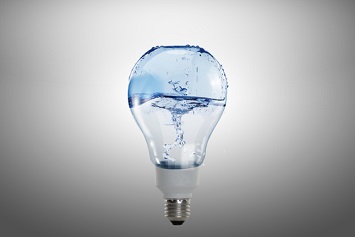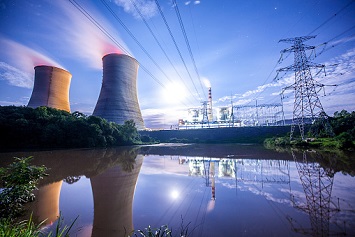The energy-water nexus is the current phrase used to connote the interdependence of energy and water. The generation of energy requires large volumes of water, mainly for cooling equipment at thermoelectric fossil fuel and nuclear power plants; much less water is needed for renewable energy, such as wind and solar.
Public water systems need substantial amounts of energy to run pumps and conduct treatment, among other functions. It is difficult to conceive how nonrenewable energy could function without water or how the public, agriculture, and businesses could receive a sufficient supply of water without adequate electrical power. And yet these indispensable and mutually dependent sectors often do not function in a cooperative and efficient way. Power plants withdraw more water than any other sector. These withdrawals put pressure on public water supplies and agriculture in arid parts of the country. Many public water systems run old pumps that waste almost as much energy as they use, resulting in high energy costs. Moreover, when less water is available from a traditional source, additional water must be conveyed over longer distances, requiring even more energy.
The energy-water nexus is further complicated by environmental issues. Climate change and rising temperatures are straining water resources in some parts of the country. This means that less water is available for power plant operations. Also, because surface water is often warmer than needed, more must be drawn in to provide sufficient cooling. In addition, there have been instances of power plants temporarily shutting down because of insufficient water or temperature concerns. Furthermore, these cooling problems typically occur during hot weather when there is a demand for more electrical power for air-conditioning. A major environmental concern is the process of using once-through water for cooling at power plants. These water withdrawals pull aquatic organisms into the plant or trap them against screens; the resulting mortality rate is high. Furthermore, after it has cooled the power plant systems, water is returned to water bodies at a higher temperature, which also has detrimental effects on aquatic life and ecosystems.
Ways to improve the sometimes-counterproductive relationship between energy and water for the benefit of all stakeholders have been under study for some time. For example, in 2011, the Government Accountability Office (GAO) reported in Energy-Water Nexus that while few nationwide studies have been conducted on the amount of energy used to provide drinking water and wastewater services, there are technologies and approaches that can improve the energy efficiency of drinking water and wastewater processes. But new and more efficient equipment is costly, and public water systems typically must first use their limited funds to ensure the provision of clean drinking water before they can upgrade to more efficient equipment.
Water Intensity Is Down
Since 2011, the nexus has shown some signs of improvement on the energy side with the growth of renewable generation, which requires little and sometimes no water. Also, advancements such as the installation of cooling towers at power plants, which enable recycling of water for cooling, has somewhat reduced the demand for freshwater. In November 2018, the Energy Information Administration (EIA) reported that the water intensity of total U.S power generation—the average amount of water withdrawn per unit of total net electricity generated—fell from 15.1 gallons (gal) per kilowatt-hour (kWh) in 2014 to 13.0 gal per kWh in 2017. But thermoelectric power still accounts for more than 40 percent of all water withdrawals in the United States, about 133 billion gallons a day (BGD) according to the U.S. Geological Survey. Withdrawals for irrigation and public water are estimated at 118 BGD and 39 BGD respectively. According to the EIA, in 2017, energy withdrawals were more than twice the amount that flows over the Niagara Falls each year.
While power plants have been making progress in water efficiency, public water systems have much farther to go in energy efficiency. According to testimony by one witness at a House hearing in March 2019, research has shown that the average energy efficiency of existing water utility pumps in the field is approximately 55 percent, which means that about 45 percent of the energy used is lost to inefficiency.
The intent of the House hearing was to solicit expert testimony on the state of the energy-water nexus and measures that can be taken to improve the relationship. Congress has made gestures to address the issue. For example, a bill introduced by Rep. Eddie Bernice Johnson (D-TX), who chairs the Committee on Science, Space, and Technology, would direct the Department of Energy (DOE) to incorporate the consideration of water use and treatment into all its relevant research, development, and demonstration programs and additional coordination functions to ensure that this issue is given adequate attention and resources moving forward. The DOE would also need to take specific steps to research and advance energy-efficient technologies for water distribution, treatment, and collection systems.
Why a Disconnect?
Given the strong interdependence of energy and water, why do the two seem to operate under separate regimes to the advantage of neither?
Several explanations were offered by Kate Zerrenner, the senior manager of the Environmental Defense Fund’s Energy-Water Initiatives, who gave the most comprehensive picture of the energy-water nexus at the hearing. According to Zerrenner, the most fundamental problem may be the absence of a common language. Even something as ostensibly simple as measurement can be an obstacle. “Electricity is measured in megawatt-hours (MWh) or megawatts (MW), and water is measured in gallons or acre-feet, neither of which is meaningful to the other sector,” said Zerrenner. She also described several of the broader discrepancies.
- Policy development, technological advancements, and investment opportunities for energy and water are largely independent rather than coordinated. Even municipalities that own and operate their water and electric utilities often have planning and management systems that operate as though under separate authorities.
- Energy and water policies at both the federal and state levels are outdated. For example, they were developed to support traditional central thermal power plants, which are both highly water- and energy-intensive processes.
- Policy and regulatory barriers inhibit cross-sector coordination. The power sector operates under national reliability standards (top-down), while water is much more localized (bottom-up). Each sector has its own regulatory framework and oversight agencies at the state and federal levels, as well as workforce training structures that are not aligned with each other.
- Water planners typically assume they have the energy they need, and energy planners assume they have the water they need. A mismatch in planning objectives by different actors can prevent the beneficial siting and combining of technologies.
- To a large extent, the energy sector is market-based and run by private, often big companies acting on regional, national, or global markets. Energy efficiency is a driving force for development. Energy is priced on the market, and there is a high awareness about energy prices among customers.
- The water sector, on the other hand, is dominated by small public utilities acting on regulated markets at the local municipal level. Water is largely characterized by inefficient use or overuse, and incentives for technical advancements are insufficient. There is low customer awareness of water prices, and marginal cost pricing or cost-recovery pricing is common. The price of water is set based on principles that include affordability and accessibility, and the price does not typically reflect the supply technique or treatment process. The existing water price also does not capture region-specific water conditions or relative water scarcity. As a result, the cost of water can be a small share of overall energy production cost, even for water-intensive users.
- Private companies acting under market forces often dictate the location of energy infrastructure whereas water infrastructures are often located using more public interest criteria.
Better Communication Needed
Several witnesses indicated that resolution of some of these differences must start with the two sectors doing a better job of talking to each other. Vincent Tidwell, PhD, a member of the technical staff at Sandia National Laboratory, said integrated planning will improve communication. Tidwell stated:
“I am speaking of integrated planning where energy, water, and environmental managers work together to manage these interacting resources. Sandia, aided by other National Laboratories … [has] helped bring the nation’s three large electric interconnections (Western Electricity Coordinating Council, Eastern Interconnection Planning Cooperative, and the Electric Reliability Council of Texas) together with state water managers to integrate water into long-term transmission planning. Specifically, we have provided data, modeling, and analysis to determine where the availability of fresh water or the cost of a non-fresh sources [sic] of water might limit the siting of new thermoelectric generation. We have also helped identify potential changes in water supply, electricity demand, and hydropower scheduling due to a changing and variable climate.”
Zerrenner has also seen progress in communication.
“Both sectors are starting to realize that not only is there a benefit to collaboration, but there is also an imperative to do so as resources in both sectors are coming under greater strain,” she told lawmakers. “In November 2014, the National Association of Regulatory Utility Commissioners (NARUC) adopted a resolution to work with appropriate federal authorities to pursue flexible regulatory reforms in energy efficiency in support of the energy-water nexus. And the Western Governors Association has elevated energy-water issues in its planning discussions.”
The Next Steps
As noted, different approaches and new technologies are available both to cut down water use by utilities and improve energy efficiency by water systems. For example, one witness pointed out that some utilities are acquiring treated sewage water for cooling; the witness added that the prospects for this approach may be limited because municipalities are charging for this water. Desalination technologies, as well as the use of corrosion resistant materials in thermoelectric plants, are also available and can expand the use of seawater for cooling. A witness said the DOE is pursuing a national research effort intended to lower the cost and energy requirements of desalination and treatment of nontraditional water sources.
Another long-term approach suggested by Zerrenner is to build water grids similar to electric power grids. This transition would begin with the wider installation of smart water meters.
“While smart meters are increasingly deployed in electrical grids, monitoring of water infrastructure lags significantly,” testified Zerrenner. “Networks of remote, automated leak detection could help in prioritizing repairs to aging water infrastructure, with concomitant energy savings, particularly in locales with high embedded energy costs of water, such as Southern California and the Southwest.”
Zerrenner says the resulting data would also enable better cost-benefit water planning, identify anomalies in the system, prioritize and inform policies and implementation efforts, identify conservation potential for customers, and provide a mechanism for customer feedback about the rate of consumption and impact of that consumption.
Again, smart water meters would be only one part of the grid approach. “Although discussions about meters are plentiful, integrative, strategic, and macro-level discussions of smart water grids are lacking in academic and other literatures,” Zerrenner adds.
Testimony from the House hearing is available here.


